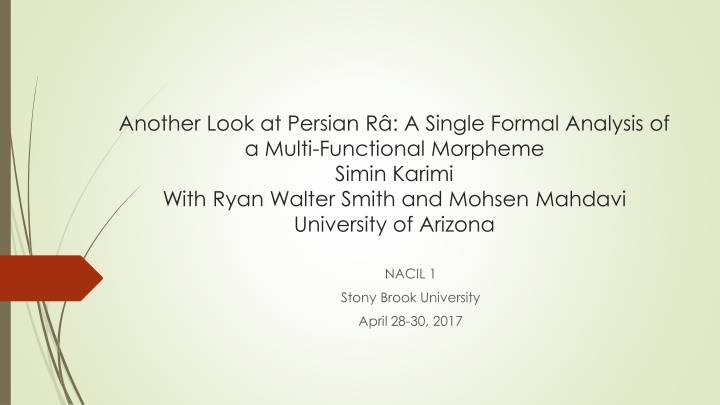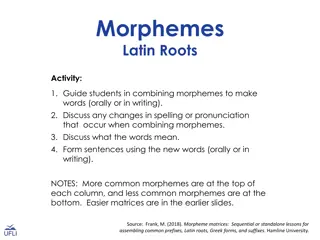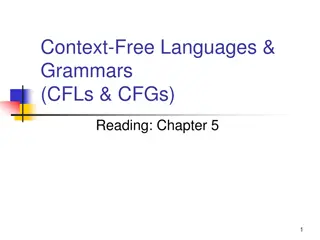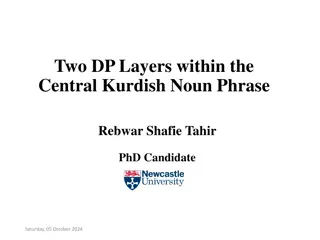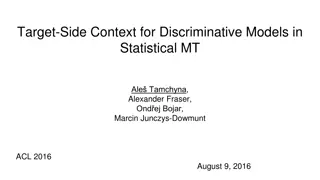Analysis of Persian Morpheme -r in a Multifunctional Context
This analysis delves into the various functions of the Persian morpheme -r as a differential object marker, examining its presence on different types of objects and proposing a case system to explain its distribution. The study explores how -r marks specific DPs in Persian sentences and its implications within a general case system framework.
Download Presentation

Please find below an Image/Link to download the presentation.
The content on the website is provided AS IS for your information and personal use only. It may not be sold, licensed, or shared on other websites without obtaining consent from the author.If you encounter any issues during the download, it is possible that the publisher has removed the file from their server.
You are allowed to download the files provided on this website for personal or commercial use, subject to the condition that they are used lawfully. All files are the property of their respective owners.
The content on the website is provided AS IS for your information and personal use only. It may not be sold, licensed, or shared on other websites without obtaining consent from the author.
E N D
Presentation Transcript
Another Look at Persian R: A Single Formal Analysis of a Multi-Functional Morpheme Simin Karimi With Ryan Walter Smith and Mohsen Mahdavi University of Arizona NACIL 1 Stony Brook University April 28-30, 2017
Introduction Cross-linguistically, there are two classes of objects Overtly marked (Differential Object Marking (DOM)) Not marked DOM may take the form of case (e.g., Hindi, Turkish, Hebrew), dposition (e.g., Spanish), agreement (e.g., Swahili, Senaya), or clitic-doubling (e.g., Macedonian, Catalan).
Introduction Universally, common factors distinguishing objects are definiteness, specificity, and animacy, In general, objects high on the relevant scale (e.g., more definite) are marked. One of the well-known instances of DOM is found in Hindi, where objects are differentiated based (mainly) on specificity: with -ko (which is also the canonical dative case marker) when they are specific (Bhatt 2007).
Introduction In Persian, the morpheme -r has been typically treated as a differential object marker which appears on specific direct objects (Browne 1970, Karimi 1990), or definite objects (Mahootian, 1992, Ghomeshi 1996, among others). The unmarked word order has been generally shown to place the object+r in a higher position than the unmarked object, hence suggesting a topical interpretation of elements carrying this element (Windfuhr 1979, Ghomeshi 1997).
Introduction There are, however, several cases in which the morpheme -r appears on DPs other than the direct object, including: Raised subjects out of an embedded clause DP corresponding to a clitic inside an object, a case of double DP+r construction. DP corresponding to a clitic object of a preposition. Nominal adverbials. Other types of DPs. In some cases, the predicate is unergative instead of transitive
Introduction Questions What is the real function of r ? What do DPs marked by -r have in common? In order to respond to (1) we need to understand (2) first. Goal: to propose a case-system that explains the distribution of the morpheme r as well as lack of it (subjects and objects of prepositions) in a natural and explanatory fashion.
Introduction In this article, we analyze The DP+r within the framework of a general case system in line with some aspects of Marantz s (1991) disjunctive case hierarchy. Based on the data, we motivate a new analysis of r which indicates that this element marks specific DPs that have been valued for dependent case.
Introduction In contrast to Marantz for whom dependent case is a post-syntactic phenomenon, we argue that accusative case is structurally assigned downwards in syntax This happens if the local predicate introduces an external argument.
Introduction This article also builds on work by Preminger (2011a, 2014) and Kornfilt & Preminger (2014), which argue, on the basis of Sakha (a Turkic language), that nominative (as well as absolutive, and within the DP, genitive cases) are simply the morphological form afforded to noun phrases whose case features have not been valued in the course of the derivation. This means that subject DPs are not valued for case.
Introduction The theory adopted in this article predicts that raised subjects of embedded clauses may only appear with -r if the matrix verb introduces an external argument. We show that this predication is borne out. Finally, the analysis is extended to those cases in Modern Classical Persian where r marks a variety of DPs other than objects.
Organization Data Theoretical background Analysis Predictions Classical Modern Persian Conclusions
Data It is well-known that specific/definite objects, but not nonspecific ones, are marked in Persian. Furthermore, -r is obligatory if the DP is specific/definite. (1) Kimea be man ket b d d Kimea to me book gave Kimea gave me (a) book/books. (2) Kimea in ket b *(-ro) be man d d Kimea this book r to me gave Kimea gave me this book.
Data Subjects, as well as objects of prepositions, are not marked by r . (3) Kimea-(*ro) ket b xund Kimea-r book read Kimea read books. (4) Kimea be Parviz (*ro) goft Kimea to Parviz r said Kimea told Parviz.
Data This is true of embedded subjects as well. (5) man fekr I thought Asp-do-1SG that Ali -r winner Asp-become-3SG I know Ali will win (become a winner). mi-kon-am [CPke Ali (*ro) barande mi-sh-e.
Data However, embedded subjects may be marked by r if raised into the higher clause. In (6), the raised subject has moved into the main clause. (6) Ali-ro pro fekr thought Asp-do-1SG that winner mi-kon-am [ (ke) e barande be-sh-e ] Ali-r Subj-become-3SG As for Ali, I think he wins Topic It is Ali who I think will win. Contrastive Focus
Data Topicalized DPs corresponding to the object of a preposition are also marked by r . (7) man Pari-ro b -h sh I Pari-r As for Pari, I talked with her. harf zad-am with-her talk hit-1SG
Data DPs corresponding to clitics inside an object are marked by r as well. (8) pro m shin-ro dar - esh-ro bast-am car-r door-its-r As for the car, I closed its door. close-1SG (Karimi 1989)
Data (9) a. pro m m n-eAli ro did-am mom-EZ I saw Ali s mom. Ali r saw-1SG . b. pro Ali-ro m m n-esh -ro did-am. mom-his r saw-1SG As for Ali, I saw his mom Ali-ro
Data Note, however, that the same pattern does not hold when the topicalized DP corresponds to a clitic pronominal inside a subject. (10) a. x har - e sister Sahar s sister comes. Sahar (*ro) Sahar mi-y- d. Asp-3SG Ez b. Sahar (-*ro) x har-esh Sahar - r sister-her As for Sahar, her sister will come. mi-y- d, certain-is
Data Nominal adverbs may be marked by r , even in the absence of a transitive verb. (11) a. man fard -ro tu xune mi-mun-am I tomorrow-r in house Asp-stay-1SG As for tomorrow, I will stay at home.
Data b. pro shab-e pish-o aslan night-Ez last-r at all Neg slept-1sg It was last night that I didn t sleep at all. (the entire night) or As for last night, I didn t sleep at all. na - x bid-am (Karimi 1997)
Data Finally, some other type of non-object DPs may be marked by-r in the absence of a transitive verb. (12) m in r h-ro b with each other went-1PL ham raft-im we this way-r We have gone this way with each other.
Theoretical background In The Minimalist Program (Chomsky 1995) and subsequent work (Chomsky 2000, 2001), Case is seen as a semantically uninterpretable feature on nominals, thereby requiring deletion before the semantic interface (LF).
Theoretical background (14) Structural Case is not a feature of the probes (T, v), but it is assigned a value under agreement. The value assigned depends on the probe: nominative for T, accusative for v. (Chomsky 2001:6)
Theoretical background There are other approaches to case assignment which consider Accusative Case as a dependent case, and do not take unmarked cases like nominative to be positively specified. Marantz s (1991) disjunctive case hierarchy is a prominent example. That portion of Marantz s proposal relevant to our discussion appears in (15).
Theoretical background (15) Marantz s Disjunctive case hierarchy i. some higher functional projection or a set of such projections (Accusative in Nom-Acc languages, Ergative in Erg-Abs languages). Dependent case: case is dependent upon the presence of ii. Unmarked case: assigned when a DP appears embedded in a certain structural position (genitive in NPs, nominative in Spec- IP/TP).
Theoretical background For Marantz, case assignment is a post-syntactic property that applies to the output of the syntactic operations.
Theoretical background Preminger (2011a, 2014) gives the same case assignment algorithm a purely syntactic implementation in contrast to Marantz s original proposal. In this implementation, cases like nominative and absolutive (and within the DP, genitive) are simply the morphological form given to noun phrases whose case features have not been valued in the course of the derivation.
Theoretical background Baker and Vinokurova (2010), Kornfilt and Preminger (2014) and Baker (2017) show that accusative in Sakha, a Turkic language, can only be analyzed as dependent case in syntax.
Theoretical background (16) a. Min[sarsyn ehigi-(*ni) kel-iex-xit dien] ihit-ti-m. I.NOM tomorrow you-(*ACC) come-FUT-2pS that hear-PAST-1sS I heard that tomorrow you will come. b. Min[ehigi-ni [b g n -- kyaj-yax-xytdien]] erem-mit-im. I you-ACC I hoped that you would win today. today win-FUT-2pSthat hope-PTPL-1sS (Baker 2017)
Theoretical background (16a) shows that a subject properly contained in an embedded clause cannot get accusative case in Sakha. (16b) shows that if the subject moves to the edge of the embedded clause, then it can get accusative case under the influence of the matrix clause.
Theoretical background In this work, we adopt the following proposal: (17) Case valuation a. Accusative Case is a dependent Case that is valued downwards inside vP. b. Accusative Case is valued only when the verb assigns an external theta role. c. Nominative Case is unvalued.
Theoretical background (17a) and (17c) are represented by the configuration in (18). (18) TP VoiceP Nominative (unvalued) vP Accusative (valued)
Theoretical background (17b) is an extension of Burzio's Generalization (19)Burzio's Generalization A verb which lacks an external argument fails to assign Accusative Case. (Burzio 1986:178-9)
Theoretical background As we see in the next section, the generalization in (19) is extended to cases where a verb assigns Accusative Case to a DP outside of its own thematic domain. This is reminiscent of ECM in English.
Theoretical background Furthermore, Following Karimi (2005) we assume that both types of objects are base-generated Inside the PredP (=VP). The specific object moves into a higher position, possibly the Specifier of vP, to escape the novelty domain (Heim 1981, Diesing 1992, Holmberg & Nikanne 2002).
Theoretical background (20) vP DPS vP DPo v PredP v to
Theoretical background Finally, we suggest a post-syntactic r -marking, as in (21): (21)Post-syntactic r -Marking DPSpecific+Accusativis marked by r at the morphological interface post-syntactically.
Theoretical background One final remark: Our definition of specificity is based on En (1992). She defines specificity in terms of strong antecedent and weak antecedent.
Theoretical background A definite DP requires a strong antecedent based on an identity relation between this type of DP and its previously established discourse referent. Therefore, definite DPs are always specific. An indefinite DP is specific if it denotes an inclusion relation to previously established discourse, representing a weak antecedent. A nonspecific DP lacks an antecedent in the discourse altogether.
Analysis We start with the most obvious cases, namely specific direct objects. The example in (2) is repeated here in (22). The object, still inside the vP, is valued for Accusative case. (22) Kimea [vPin ket b *(-ro) [PredPbe man d d ]] Kimea this book r Kimea gave me this book. to me gave
Analysis This analysis is extended to those cases with double DP+r , as in (8), repeated in (23). (23) pro [m shin-ro]i dar e-shi-ro car-r door-Ez-its-r As for the car, I closed its door. bast-am close-1SG (Karimi 1989) m shin-ro corresponds to the clitic inside the object. We suggest that it is base generated inside the vP, possibly in the Specifier of that phrase, and is valued for accusative case.
Analysis As for the object of a preposition, the statement in (17a) correctly predicts that it cannot be marked by r since it is embedded inside PP. The example in (4), repeated as (24) exemplify this fact: (24) Kimea [PPbe Parviz (*ro)] goft Kimea to Parviz r Kimea told Parviz. said
Analysis The DP+r in (7), repeated in (25), corresponds to a clitic object inside PP. We suggest that this DP, similar to the one in (23) is valued for Accusative case in the Specifier of vP, and is marked by r post-syntactically. (25) man [Pari-ro]i I Pari-r As for Pari, I talked with her. [b -h shi] harf zad-am with-her talk hit-1SG
Analysis Next, let s consider the case of non-object DPs in an intransitive construction, as in (12), repeated in (26). (26) m [in r h]i-ro we this way-r As for this way, we have gone with each other. [vPti b with each other went-1PL ham raft-im
Analysis The statements in (17a) and (17b) explain the appearance of r in this context. The verb raftan (to go) is an unergative verb that assigns an external theta role, and thus v values Accusative Case on the DP r h while still inside vP, per Burzio's Generalization in (19).
Analysis Nominal adverbials are next. Cinque (1999) suggests a sequence of High and Low adverbials to appear at the edge or inside the verb phrase. Based on this proposal and Karimi (2005), we assume that adverbs, including high adverbials, are either adjoined to vP or inside it. Thus they may be valued for Accusative case if nominal. This analysis is borne out evident by the data in (11), restated in (27).
Analysis (27) a. man [vPfarda]-ro I tomorrow-r tu xune mi-mun-am ] in house Asp-stay-1SG As for tomorrow, I will stay at home. b. pro [vPshab-e pish-o aslan night-Ez last-r na - x bid-am] at all Neg slept-1SG It was last night that I didn t sleep at all. (the entire night) , or As for last night I didn t sleep at all.
Analysis Finally, the example in (3), restated in (28), shows that the subject DP cannot be marked by r . This follows from (17c), stating that Nominative case is not valued, and thus not marked. (28) [VoicePKimea-(*ro) [vPket b xund ]] Kimea-r book read Kimea read books.
Analysis Note that the DP corresponding to the clitic pronoun inside the subject in (10), repeated in (29b), cannot be marked either. This is predicted by our analysis: the topicalized DP is high in the structure, and thus is not subject to dependent case.
